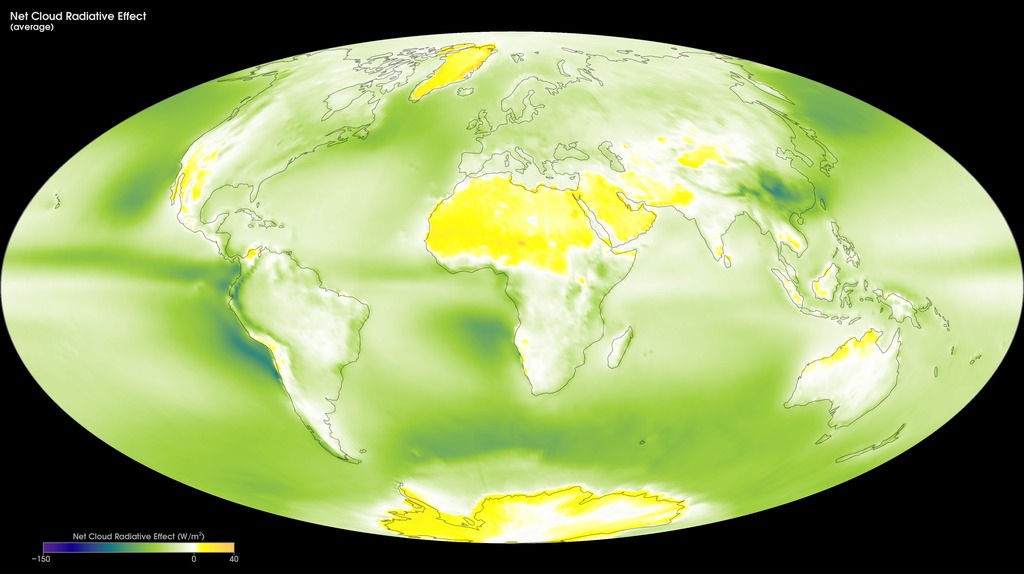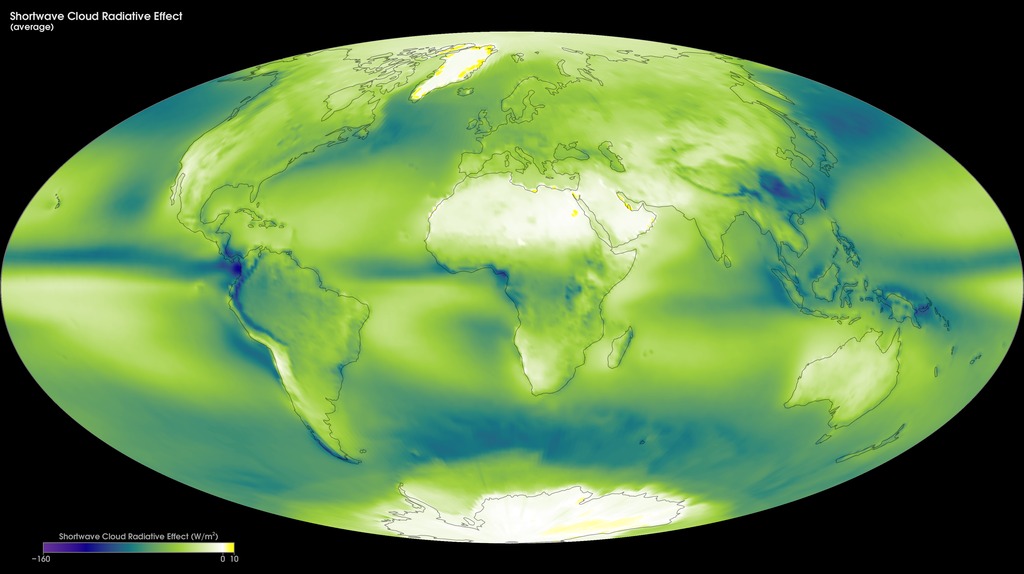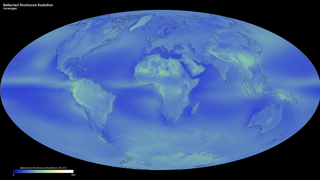Earth
ID: 30603

Clouds exert a big influence on the Earth's climate. Two of the main reasons are that they increase the amount of solar radiation reflected back to space (a cooling effect) and decrease the amount of thermal infrared radiation escaping to space (a warming effect). From a surface observer's perspective the opposite occurs: clouds decrease the amount of sunlight and increase the amount of thermal radiation reaching the surface. We can measure these two cloud radiative influences using satellie instruments such as the Clouds and the Earth's Radiant Energy System, or CERES, satellite.
A simple way to describe the effect of clouds on the Earth's energy budget is the cloud radiative effect, which is the amount of radiative energy that would return to space if there were no clouds, minus the amount that actually escapes with clouds present. For solar radiation this quantity is usually negative (clear skies reflect less sunlight back to space than cloudy ones) while for thermal radiation it is positive (clear skies allow more radiation escape than cloudy ones). The net effect of clouds is the sum of these opposing effects. Current satellite observations indicate that the sum is negative overall, i.e., clouds cool the climate. It is still uncertain whether clouds will cool more or less in a changed climate.


CERES Cloud Radiative Effect

A simple way to describe the effect of clouds on the Earth's energy budget is the cloud radiative effect, which is the amount of radiative energy that would return to space if there were no clouds, minus the amount that actually escapes with clouds present. For solar radiation this quantity is usually negative (clear skies reflect less sunlight back to space than cloudy ones) while for thermal radiation it is positive (clear skies allow more radiation escape than cloudy ones). The net effect of clouds is the sum of these opposing effects. Current satellite observations indicate that the sum is negative overall, i.e., clouds cool the climate. It is still uncertain whether clouds will cool more or less in a changed climate.


Related
For More Information
Credits
Marit Jentoft-Nilsen: Project Support
Heather Hanson (GST): Writer
Amy Moran (Global Science and Technology, Inc.): Project Support
Heather Hanson (GST): Writer
Amy Moran (Global Science and Technology, Inc.): Project Support
Please give credit for this item to:
NASA
NASA
Short URL to share this page:
https://svs.gsfc.nasa.gov/30603
Missions:
Aqua
Terra
Data Used:
Note: While we identify the data sets used in these visualizations, we do not store any further details nor the data sets themselves on our site.
Keywords:
SVS >> HDTV
GCMD >> Earth Science >> Atmosphere >> Clouds >> Cloud Forcing
SVS >> Hyperwall
NASA Science >> Earth
SVS >> Presentation
GCMD keywords can be found on the Internet with the following citation: Olsen, L.M., G. Major, K. Shein, J. Scialdone, S. Ritz, T. Stevens, M. Morahan, A. Aleman, R. Vogel, S. Leicester, H. Weir, M. Meaux, S. Grebas, C.Solomon, M. Holland, T. Northcutt, R. A. Restrepo, R. Bilodeau, 2013. NASA/Global Change Master Directory (GCMD) Earth Science Keywords. Version 8.0.0.0.0
https://svs.gsfc.nasa.gov/30603
Missions:
Aqua
Terra
Data Used:
Terra/CERES
The CERES instrument aboard many Earth-orbiting satellites records the flow of reflected Solar radiation and reprocessed longwave radiation in the Earth's radiation budget.
Aqua/CERES
The CERES instrument aboard many Earth-orbiting satellites records the flow of reflected Solar radiation and reprocessed longwave radiation in the Earth's radiation budget.
Keywords:
SVS >> HDTV
GCMD >> Earth Science >> Atmosphere >> Clouds >> Cloud Forcing
SVS >> Hyperwall
NASA Science >> Earth
SVS >> Presentation
GCMD keywords can be found on the Internet with the following citation: Olsen, L.M., G. Major, K. Shein, J. Scialdone, S. Ritz, T. Stevens, M. Morahan, A. Aleman, R. Vogel, S. Leicester, H. Weir, M. Meaux, S. Grebas, C.Solomon, M. Holland, T. Northcutt, R. A. Restrepo, R. Bilodeau, 2013. NASA/Global Change Master Directory (GCMD) Earth Science Keywords. Version 8.0.0.0.0












